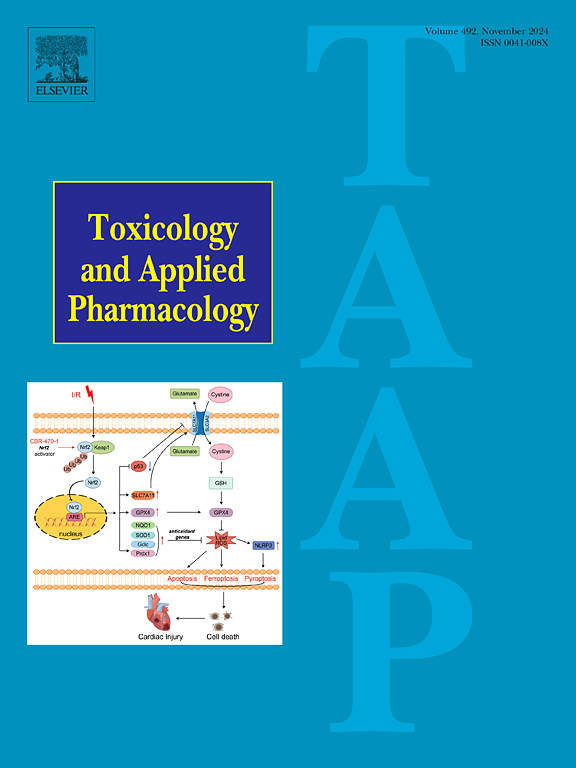斑马鱼早期发育阶段的神经毒性研究。
IF 3.3
3区 医学
Q2 PHARMACOLOGY & PHARMACY
引用次数: 0
摘要
Cenobamate (CNB)是一种新型抗癫痫药物,治疗癫痫疗效显著。然而,在临床试验中,患者最常见的不良反应是中枢神经系统(CNS)症状。在动物研究中,妊娠期或哺乳期服用CNB会对后代的神经发育产生不良影响。为了优化CNB的临床应用,我们研究了不同浓度CNB(10、20、40、80和160 μM)对斑马鱼胚胎的神经毒性。暴露后,斑马鱼胚胎表现出异常表型,如体长缩短,卵黄囊吸收受损,心率降低。行为学实验表明,CNB可导致小鼠自发卷尾频率降低、总运动距离缩短、平均运动速度降低等异常运动。我们还发现,CNB导致斑马鱼胚胎中乙酰胆碱酯酶(AChE)活性水平升高,同时神经发育相关基因如巢蛋白、gfap、突触素IIa和gap43的差异表达。综上所述,我们的研究结果表明,CNB可能通过改变神经递质系统和神经发育基因的表达来诱导斑马鱼胚胎的发育和神经毒性作用,从而影响行为。本研究将为CNB的临床应用提供信息,旨在通过适当的给药使更多的癫痫患者受益。本文章由计算机程序翻译,如有差异,请以英文原文为准。

Neurotoxicity study of cenobamate-induced zebrafish early developmental stages
Cenobamate (CNB) is a novel anti-seizure medication with significant efficacy in treating epilepsy. However, in clinical trials, the most common adverse reactions observed in patients are central nervous system (CNS) symptoms. In animal studies, administration of CNB during pregnancy or lactation has been associated with adverse effects on neurodevelopment in offspring. To optimize the clinical use of CNB, we investigated the neurotoxicity of different concentrations of CNB (10, 20, 40, 80, and 160 μM) on zebrafish embryos. Following exposure, zebrafish embryos exhibited abnormal phenotypes such as shortened body length, impaired yolk sac absorption, and decreased heart rate. Behavioral experiments showed that CNB caused abnormal movements such as decreased spontaneous tail curling frequency, shortened total movement distance, and reduced average movement speed. We also found that CNB leads to increased acetylcholinesterase (AChE) activity levels in zebrafish embryos, along with differential expression of neurodevelopment-related genes such as nestin, gfap, synapsin IIa, and gap43. In summary, our research findings indicated that CNB may induce developmental and neurotoxic effects in zebrafish embryos by altering neurotransmitter systems and the expression of neurodevelopmental genes, thereby influencing behavior. This study will provide information for the clinical use of CNB, aiming to benefit more epilepsy patients through its appropriate administration.
求助全文
通过发布文献求助,成功后即可免费获取论文全文。
去求助
来源期刊
CiteScore
6.80
自引率
2.60%
发文量
309
审稿时长
32 days
期刊介绍:
Toxicology and Applied Pharmacology publishes original scientific research of relevance to animals or humans pertaining to the action of chemicals, drugs, or chemically-defined natural products.
Regular articles address mechanistic approaches to physiological, pharmacologic, biochemical, cellular, or molecular understanding of toxicologic/pathologic lesions and to methods used to describe these responses. Safety Science articles address outstanding state-of-the-art preclinical and human translational characterization of drug and chemical safety employing cutting-edge science. Highly significant Regulatory Safety Science articles will also be considered in this category. Papers concerned with alternatives to the use of experimental animals are encouraged.
Short articles report on high impact studies of broad interest to readers of TAAP that would benefit from rapid publication. These articles should contain no more than a combined total of four figures and tables. Authors should include in their cover letter the justification for consideration of their manuscript as a short article.

 求助内容:
求助内容: 应助结果提醒方式:
应助结果提醒方式:


